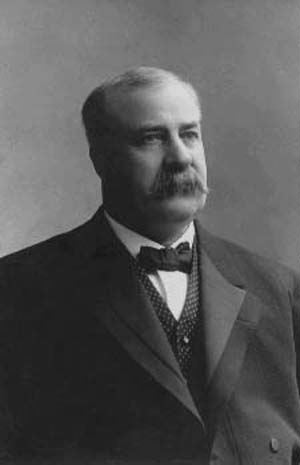Search | Image Archive | Reference | Communities | POV | Lesson Plans | Credits
 Rodmond Palen Roblin was a colourful and dominant figure in Manitoba politics for thirty years and, as premier from 1900 to 1915, he played a substantial role in shaping the political and economic future of the province.
Rodmond Palen Roblin was a colourful and dominant figure in Manitoba politics for thirty years and, as premier from 1900 to 1915, he played a substantial role in shaping the political and economic future of the province.
He was born in Upper Canada (Ontario) in 1853 and came to Manitoba in 1877 to farm near the town of Carman. In 1889 he entered the Provincial Legislature as a Conservative and as Leader of the Opposition. In 1900, he succeeded Hugh John Macdonald as Premier, taking also the two important cabinet posts of Minister of Agriculture and Railway Commissioner. That the three most important positions in cabinet belonged to one man is a reflection of the influence and power that Roblin wielded within the province, and of the control that he retained over his own cabinet.
Roblin governed the province through a period of dramatic social and economic change that placed extraordinary demands upon the government. Rapid population growth demanded new public services like schools and hospitals, while the growth of industry and commerce demanded better roads, railways and communications. The Roblin government met many of these demands by dramatically increasing the role of government in creating such infrastructure.
The government created a public health nursing service, opened a Tuberculosis Hospital and rebuilt or expanded the province's gaols and mental hospitals (Regular hospitals in this period were still run by public charities and churches.). It allocated considerable resources to education. Normal Schools were established to train teachers and the University of Manitoba and the Manitoba Agricultural College were placed on new and larger campuses.
The Roblin government also intervened in some areas which had previously been the domain of private enterprise and created Manitoba's first crown corporations. In 1908, the government responded to the high cost and inefficiency of telephone services and expropriated Bell Telephones to create Manitoba Government Telephones, later the Manitoba Telephone System. In 1910, the government responded to the shortage of grain storage and began construction of dozens of new elevators owned by Manitoba Government Elevators.
In 1914, it passed the Good Roads Act, by which it made money available to municipalities to build roads and ditches. This was the first step in the creation of a provincial highways system. These, among other public works, like the elaborate municipal buildings in many Manitoba towns, are in large part the legacy of the Roblin government.
The Roblin conservatives were reluctant to lead the province on social issues. Rodmond Roblin himself was strongly opposed to women's suffrage, and there was a very public feud between himself and the suffragist leader Nellie McClung. Roblin was similarly unwilling to make dramatic changes to labour relations, or even to take steps to ensure that existing labour standards were properly enforced.
Roblin also retained tight personal control over the province and the government. Although patronage was an accepted part of government, "the chief" employed it to an unprecedented extent, and there were numerous accusations of corruption. Indeed, the public works initiatives of the government were to bring it down.
Many of the pubic buildings erected under the Roblin government went wildly over-budget, and there were numerous accusations of misappropriation of money and materials. Nowhere was this more obvious than in the construction of the new Legislative Building, where the budget was dramatically exceeded. In 1915, Roblin was forced to resign over the Legislature Scandal, and although the subsequent Royal Commission found no fault with him, he retired with a mixed legacy, remembered both for his corrupt political "machine" and for presiding over a period of dramatic growth in public institutions.
Page revised: 23 August 2009